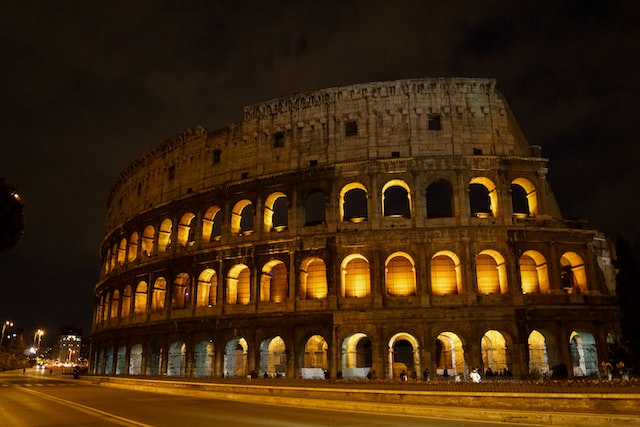The Colosseum, also known as the Flavian Amphitheatre, is a large elliptical amphitheater located in the center of Rome, Italy. It is considered one of the greatest engineering feats of ancient times and is one of Rome’s most famous landmarks. The Colosseum is a symbol of Imperial Rome and is considered one of the greatest examples of Roman architecture and engineering.
The history of the Colosseum
The Colosseum was built in AD 80-82 under the Roman emperors Vespasian, Titus, and Domitian. The Colosseum was built on the site of Nero’s palace, the Golden House, which had been destroyed in the Great Fire of Rome in AD 64.
The Colosseum was used for gladiatorial contests, public spectacles, and other entertainment events. It is estimated that the Colosseum could hold up to 50,000-80,000 people, making it one of the largest amphitheaters in the world. Gladiatorial contests were held at the Colosseum as early as AD 80, and they quickly became a popular form of entertainment for the Roman people.
During the early centuries of the Colosseum’s use, gladiatorial contests and other public spectacles were held there on a regular basis. The gladiatorial contests were brutal and often deadly, but they were also very popular with the Roman people. The Colosseum also hosted other types of events, such as mock sea battles and animal hunts.
Over the years, the Colosseum was used for various purposes, and it was also damaged several times by natural disasters such as earthquakes and fires. During the medieval period, the Colosseum was used as a quarry for building materials. In the 19th century, the Colosseum was rediscovered and became a popular tourist destination, and several restoration projects were launched to preserve the structure for future generations.
Nowadays, the Colosseum is one of the most popular tourist attractions in Rome, and it is estimated that about 7 million people visit it every year. It is considered one of the greatest engineering feats of ancient times and is one of Rome’s most famous landmarks. The Colosseum is a symbol of Imperial Rome and is considered one of the greatest examples of Roman architecture and engineering.
The architecture of the Colosseum
The architecture of the Colosseum is a testament to the engineering and construction skills of the ancient Romans. The structure is made mostly of travertine limestone and tuff, with a concrete core. The Colosseum is an elliptical shape, measuring 188 meters by 156 meters, and stands at a height of approximately 48 meters.
The Colosseum has four levels, each with 80 arches. The arches were used to support the upper levels and provide a means of access to the different levels of seating. The arches are decorated with Corinthian capitals, which are highly detailed and ornate. The walls of the Colosseum are adorned with statues and other decorative elements, many of which were taken from other structures and repurposed for use in the Colosseum.
The top level of the Colosseum has a wooden floor, which was used to hold the velaria, a type of canvas awning that was used to protect the audience from the sun and rain. The velaria was operated by sailors, using a system of ropes and pulleys.
One of the most impressive aspects of the Colosseum’s architecture is the hypogeum, a series of underground tunnels and chambers. These were used to hold animals and gladiators before they were brought into the arena. The hypogeum was also used to control the flow of people in and out of the Colosseum, and to store equipment used in the various events.
Overall, the Colosseum’s architecture is a testament to the Roman Empire’s power and influence, as well as to the engineering and construction skills of the ancient Romans. Its architectural elements, such as arches, statues, and the hypogeum, are still used as inspiration and reference in modern times.
Tips to help you make the most of your visit to the Colosseum
Here are some tips to help you make the most of your visit to the Colosseum:
- Buy your tickets in advance: To avoid long lines and ensure you have a guaranteed spot, it’s best to purchase your tickets in advance, either online or at a ticket office.
- Arrive early: The Colosseum can get very crowded later in the day, so try to arrive as early as possible to avoid the crowds and have the best chance to take in the sights without too many people around.
- Take a guided tour: A guided tour can provide you with a lot of historical context and interesting facts that you might not know otherwise. Many tours also include access to areas of the Colosseum that are not open to the general public.
- Get the audio guide: Colosseum offers an audio guide that can be rented for an additional fee. The audio guide will provide you with information about the history and architecture of the Colosseum in different languages.
- Wear comfortable shoes: The Colosseum is a large structure, and you will be doing a lot of walking and climbing stairs, so make sure to wear comfortable shoes.
- Bring water and snacks: There are no vending machines or food stands inside the Colosseum, so make sure to bring water and snacks with you.
- Be respectful: The Colosseum is an important historical site, so please be respectful of the structure and it’s history.
The Colosseum is one of the most iconic and recognizable landmarks in the world, and it continues to be a source of fascination and inspiration for people of all ages. Despite its age and the wear and tear of centuries, the Colosseum remains an impressive architectural and engineering feat and a testament to the Roman Empire’s power and influence. It’s an important part of the world’s heritage and a must-visit destination for anyone interested in Roman history and architecture.
